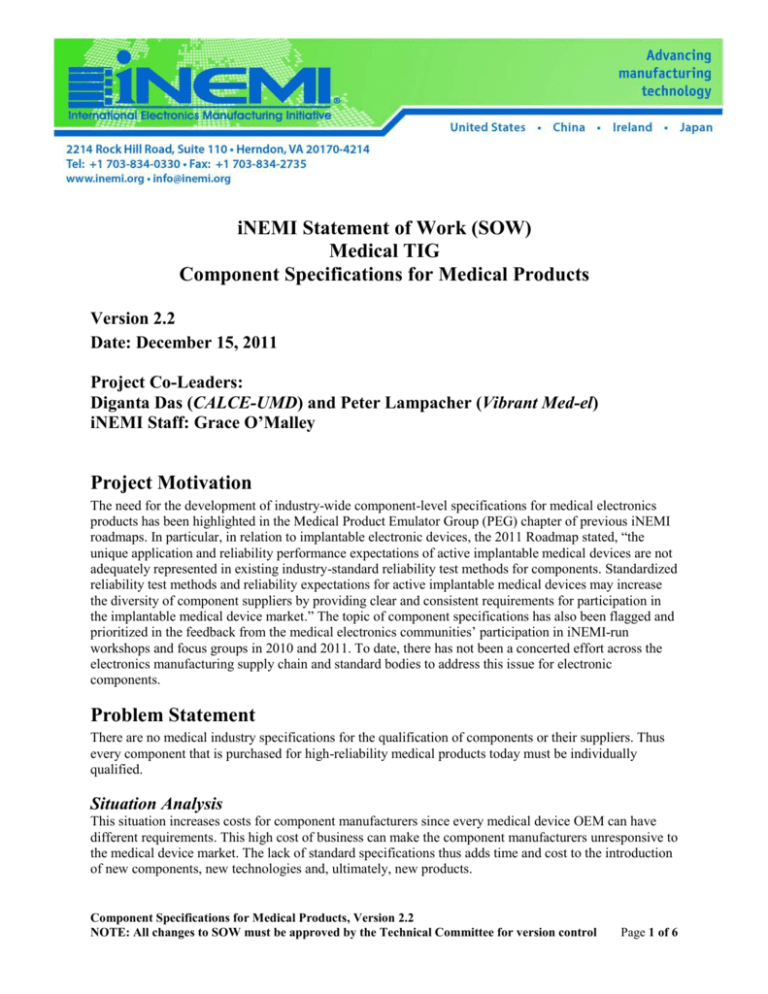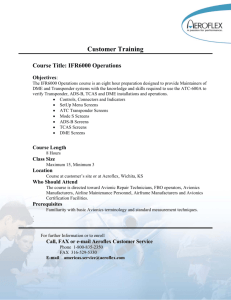Statement of Work
advertisement

iNEMI Statement of Work (SOW) Medical TIG Component Specifications for Medical Products Version 2.2 Date: December 15, 2011 Project Co-Leaders: Diganta Das (CALCE-UMD) and Peter Lampacher (Vibrant Med-el) iNEMI Staff: Grace O’Malley Project Motivation The need for the development of industry-wide component-level specifications for medical electronics products has been highlighted in the Medical Product Emulator Group (PEG) chapter of previous iNEMI roadmaps. In particular, in relation to implantable electronic devices, the 2011 Roadmap stated, “the unique application and reliability performance expectations of active implantable medical devices are not adequately represented in existing industry-standard reliability test methods for components. Standardized reliability test methods and reliability expectations for active implantable medical devices may increase the diversity of component suppliers by providing clear and consistent requirements for participation in the implantable medical device market.” The topic of component specifications has also been flagged and prioritized in the feedback from the medical electronics communities’ participation in iNEMI-run workshops and focus groups in 2010 and 2011. To date, there has not been a concerted effort across the electronics manufacturing supply chain and standard bodies to address this issue for electronic components. Problem Statement There are no medical industry specifications for the qualification of components or their suppliers. Thus every component that is purchased for high-reliability medical products today must be individually qualified. Situation Analysis This situation increases costs for component manufacturers since every medical device OEM can have different requirements. This high cost of business can make the component manufacturers unresponsive to the medical device market. The lack of standard specifications thus adds time and cost to the introduction of new components, new technologies and, ultimately, new products. Component Specifications for Medical Products, Version 2.2 NOTE: All changes to SOW must be approved by the Technical Committee for version control Page 1 of 6 Scope of Work This project will define a set of component-level reliability qualification methods (screens and tests) for electronic components use in implantable and wearable medical devices. The goal is to develop specifications that can be accepted by device OEMs as well as supported by component suppliers. These tests and screens will be identified from relevant existing tests methodologies and standards available in the electronics industry at large. Presently outside the scope of this project, but potentially other projects topics in themselves, include: 1. Creation of new tests and screens when none are found to be applicable from the existing standards. 2. Extension of the methodology to other types of components (including possibly nonelectronic components). Purpose of Project 1. The primary purpose of the project will be to develop a method for developing a test and screen matrix for electronic components that can be used to qualify the reliability performance of components for implantable and wearable electronic medical devices. Several example screen and test matrices will be included in the report as validation of the practicality of the method. 2. This project will result in a standard reliability method that can be implemented by medical device manufacturers within their component management processes. In those cases when critical defects and failure mechanisms or test methods are already known, the implementation process will be easier. For those situations in which the failure mechanisms or test methods are not known, this project will be part of a more complex solution. Project Is / Is Not Analysis This Project IS: This Project IS NOT: To define a set of reliability qualification methods on a component level accepted by OEMs (original equipment manufacturers) and supported by suppliers To define reliability qualification methods for medical devices To define: What is acceptable aging of components and what is failure A qualification effort for a specific product line at a specific supplier To quantify reliability within a suitable framework in defined operating conditions Further work on already known aging/failure mechanisms To re-use qualification methods successfully employed and rationalized in other industries To recreate the wheel of component qualification test methods and processes To create guidelines for OCMs (original component manufacturers) to utilize physics of failure based reliability assessment To create guidelines for medical OEMs on how to assess OCMs To create guidelines on minimum levels of tests for various component types Component Specifications for Medical Products, Version 2.2 NOTE: All changes to SOW must be approved by the Technical Committee for version control Page 2 of 6 Business Impact The project will result in a standardized methodology and approach across the supply chain which will reduce the time presently spent in testing unique requirements. It will also enable the faster introduction of new components and component suppliers to the supply chain, which will enable the industry as a whole to leverage the huge forecasted growth opportunities in medical electronics, while ensuring the quality and reliability performance demanded of medical applications. Outcome of Project The anticipated outcome of the project will be recommendations for common specifications for electronic components for use in medical devices that meet the test, performance and reliability needs of medical products, in particular implantable & wearable devices. Possible follow-on project topics: • Creation of new tests and screens when none are applicable in existing industry standards • Expansion to other types of components (possibly including non-electronic components) Prospective Participants Medical Device OEMs EMS companies that source components for OEMs Original Component Manufacturers (OCMs) Testing companies Industry standards bodies Project Plan Schedule The project is anticipated to take 20 months: Months 1 - 5: Task 1 - Determine the coverage of the components for the first phase Months 5 - 8: Task 2 - Identify the most common defects, degradation and failure mechanisms of the selected items under medical device applications Months 8 - 17: Task 3 - Determine the screens for identification of the defects and tests for precipitation of the mechanisms Months 12 - 19: Task 4 - Create a minimum set of tests and screens related for each component referring to industry-standard methods whenever possible Months 15 - 20: Task 5 - Final report including a methodology description on the process of developing the tests and screens for other components or parts Component Specifications for Medical Products, Version 2.2 NOTE: All changes to SOW must be approved by the Technical Committee for version control Page 3 of 6 Timeline for Project: Q1 Q2 Q3 Q4 Q5 Q6 Q7 Phase 1 Task 1 Determine the coverage of the components Task 2 Identify the most common defects, degradation and failure mechanisms Task 3 Determine the screens for identification of the defects and tests Task 4 Create a minimum set of tests and screens Task 5 Final report including a methodology description Next Phases Phase 1 – Detailed Information Task 1 - The coverage of components will be identified by conducting a survey within the medical device industry and OCMs. The survey shall be open to industry. Each contributor to the survey will be asked to provide the following information: Assign a priority to each component type, taking the following aspects into account: o Were unexpected or early component failures observed? Is there a concern that it might occur in the future? o Are certain component types used in a critical manner (i.e., failure of the components has the potential to directly cause malfunction of the entire medical device)? o Are certain component types prone to supply chain changes (e.g., relocation of OCM manufacturing sites, alternate suppliers)? o Are certain component types used in either very big or very small numbers? Specify if the information is provided by a medical device OEM or an OCM. Data (scores) will be normalized and an overall pareto will be generated. The raw data will be collected by iNEMI (or alternatively a third party) and will not be disclosed to the project participants. Only the overall paretos (medical device OEMs, OCMs, total) will be available to the project participants and will serve as a basis to identify the coverage of components. Timeline: 5 months (10 weeks to set up and test the survey, 6 weeks data collection, 4 weeks analysis and pareto generation) Component Specifications for Medical Products, Version 2.2 NOTE: All changes to SOW must be approved by the Technical Committee for version control Page 4 of 6 Task 2 - Identify the most common defects, degradation and failure mechanisms of the selected items under medical device applications. For the selected component types from Task 1, the following steps will be performed to determine the items of interest: o o o o Create a sub group of 2-3 members with specialization on the topic of interest. Review the manufacturing process and the raw material inputs and create the list of common defects in the finished components. In consultation with the device manufacturers, determine an envelope of a lifecycle profile for the components. This lifecycle profile will be determined in a conservative manner so as to cover wide range of environments, e.g., manufacture, storage, implantation, use, upgrade and removal. Determine the critical failure and degradation mechanisms of the components in the said lifecycle condition. If it turns out that the critical mechanisms under the wide lifecycle conditions are unrealistic, a subset of the applications and the lifecycle profile may be subdivided. Failure mechanism, modes, and effects analysis (FMMEA) is one method for creation of this set of critical failure mechanism set. Task 3 - Determine the screens for identification of the defects and tests for precipitation of the mechanisms. Screens: Step 1: The first step will be for the team to agree on the areas of the supply chain where the screens are possible and necessary. Step 2: Once step one is completed, participants from the agreed upon areas of the supply channel will be invited to provide considerations of screens in their area of expertise; this second step can be done in the form of a survey, or a one-time invitation by iNEMI to participate in a call. Two options are possible for this second step: 1) all the areas can provide input collectively or 2) gather the data separately for each area. Purpose of this investigation in step two is for the team to narrow down the minimum list of screens and their stages. Step 3: The third and last step is for the team to determine the form of screening in the agreed stages of the supply chain. For this step experts of the agreed area are invited to provide feedback about screening options that is collected as a step-by-step definition of the screening requirements. Tests: Based on the critical failure mechanisms determined in Task 2 and the lifecycle conditions, the subject matter expert team will review the failure models associated with the mechanisms to determine the various stresses that accelerate the failure mechanisms. The test sets to be applied on a medical device component need to cover all the failure mechanisms. The results of this evaluation will be a super set of tests that can be applied on the product for either qualification, re-qualification after product update, and process qualification after process update, and also as sample acceptance tests. These tests are not meant to be screens applied on all components but the tests performed on a sample of components from each lot or after each significant change. Task 4 - Create a minimum set of tests and screens related for each component referring to industry standard methods whenever possible. Identify the test standards that cover the various screens and tests identified in Task 3. Component Specifications for Medical Products, Version 2.2 NOTE: All changes to SOW must be approved by the Technical Committee for version control Page 5 of 6 These standards will not be limited to medical electronics but will cover the semiconductor industry, passive electronics industry, automotive, military, avionics and telecommunication standards. Identify which environments and lifecycle conditions are most closely matched with particular tests to determine the suitable test/screen from these standards. Note that these standards are to be used for the test definition only so as not to spend resources on developing already well-established methods. The sample size, acceptance conditions, test duration, preand post-test analysis can be different for the medical electronics purpose. Task 5 - Final report including example sets of reliability qualification methods for components chosen and a methodology description on the process of developing the tests and screens for other components or parts. Each team from Tasks 2, 3, and 4 will be tasked with documenting the process used by them to identify the critical failure mechanisms and defects, screens and tests, and the final test descriptions from standards. The project team will start gathering the findings as general instructions for the process. It can start as soon as the initiation of Task 4. Project Monitoring Plans Ensure open lines of communication among participants. Review all project requirements with participants before the project begins. Project participants will meet bi-weekly to review various aspects of the project and make plans for next phases of the project. Meeting minutes provided through e-mail. Follow-up with individuals on an as-needed basis. Provide any project specific monitoring or communications plans, e.g., multiple project meetings to cover multiple regions (EMEA, Asia, Americas). Workshops and face-to-face meetings as determined by the project team. Progress reports will be provided upon request for presentation at regularly scheduled iNEMI meetings (e.g. a short series of PowerPoint slides showing the work in progress at member council meetings). Track and document approximate man-months per quarter per team member (this will require the active members of the team to provide estimates). Track and document approximate number of people on the project per quarter (this can be tracked through iNEMI's WebEx account). General and Administrative Guidelines General and Administrative Guidelines for this project and all other iNEMI Projects are documented at http://thor.inemi.org/webdownload/join/gen_guidelines.pdf. Component Specifications for Medical Products, Version 2.2 NOTE: All changes to SOW must be approved by the Technical Committee for version control Page 6 of 6


